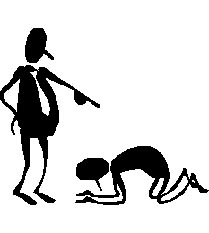
Apologize! NOW!
I have to admit to having said it to a child. How about you? (C’mon, ‘fess up).
Here’s the usual scenario that preceded the adult’s command: One youngster, usually a boy (but apparently increasing in girls), said or did something inconsiderate or hurtful to another.

One student has treated another wrongly. What is the correct course of action for us? Attend to, and sooth the victim? Punish the offender? Require “restorative justice” in which the offending student makes amends with an action that “repays” the student or “repairs” the situation? Require an apology? All of the above?
Depending on the situation, any and all of the mentioned possibilities might be implemented. Today, I’d like to talk with you more about apologies, and when and how to require them.

.Back In The Day
After stopping the behavior in its tracks, and tending to the victimized party, I would call the offender aside for a discussion. It was then that I would hear 1 of 4 utterances before I could even query the youngster:
1.“What?! I didn’t do anything.”(Yep, for some kids, denial (da Nile) ain’t just a river in Egypt.)
2. “He did it first.” Or "She made me do it." (Some blamers should only point at the mirror.)
3. “I was just telling the truth.” (Something we tell kids to do, but don’t always do it ourselves… Just ask any guy who been asked by his wife: “Do these pants make my butt look big?”)
4. “Hey, I was just kidding. It was a joke!” (A solitary laugher that others scorn.)
.
Yes, when I heard these excuses (from my male students), I was fully aware that the frontal brain lobe (the part in charge of self-preservation and experiencing empathy) of boys develops later than in girls (Sometimes not fully developed until late 20s… something I personally experienced as a high-risk adventurer with sometimes clueless jocularity when it came to commentary toward others), but we can’t allow that mistake of nature to grant a pardon to offending behavior, can we? We’ll get to that discussion shortly.
.
“The only correct actions are those that demand no explanation & no apology.” Red Auerbach
.
In any of the four cases, it was time to “back up the bus”, conducting a review of the situation, perhaps utilizing an “A-B-C analysis” to identify the sequence of events, and/or a “Problem solving meeting” to promote alternative behaviors to the obnoxious and/or inappropriate one.
Usually, there was a “reality rub” that stated, in no uncertain terms, why the demonstrated action was “out of bounds”. For example, here was my retort for the “just joking” excuse: “If a comedian tells a joke and no one laughs, is that joke funny?” (“No.”) “Right. Both parties should see the humor. If one person feels hurt by the humor, it’s not funny.” Of course, this pre-readied “off the shelf” remark fails to work when accomplices in crime joined in the unwarranted attack. Then we need to pull another ready retort off the rack.
At the end of the problem solving conference, we’d talk about solutions, payback, restitution, and other responses. Having a history of positive interactions with my kids, and a reputation for protecting all parties from attacks of any sort, I could usually coax an agreement from the youngster that (at least) an apology was needed.

.
“The ability of a person to atone has always been the most remarkable of human features.” Leon Uris
Those too, took different forms; from a sincere, heartfelt apology expressed by a self-disappointed youth to sarcastically-toned falsehoods about being “sorry”. With the latter, "I'm sorry." meant "I'm sorry that I was caught."
.
“A stiff apology is a second insult. The injured party does not want to be compensated because he has been wronged; he wants to be healed because he has been hurt.” G.K. Chesterton
.
The failure to apologize sincerely (or at all) can commonly be traced back to the home where the youngster hasn't had the opportunity to witness appropriate forms (due to parents who were inadequate in this realm). Often too, my students came from homes where apologizing was viewed as a sign of weakness, and a character trait not to be shown.
These insincere or absent statements peeved me, especially if it was the 3rd time that day that the youngster had "apologized" for the same behavior (during a day that was to hold 7 such apologies). By the end of that 7 phony-baloney excuse day, I was tempted to do things for which I would have to apologize! However, I kept chanting my mantra: “Hate the behavior, not the kid.” I would remind myself to be the kid’s partner in behavior change.
Our conference would reconvene. The usual response? Yep… “Hey, I said I was sorry. What’s the problem?” (Am I the only one that has ever heard that "cop out" from a student? I trust not.) This counterfeit atonement is seen often in celebrities and famous folks who have committed atrocious acts and major life faux pas (excuse my French), go into “rehab” for 2 weeks, exit claiming to be cured, and offer a twitter-based apology as they’re signing the contract for a prime-time TV interview or Playboy magazine photo shoot. (All before doing the same vile behavior again next month.)
.
"I can wholeheartedly apologize for not being at all sorry. And it really is the least I can do."
April Winchell
.
Should We Make Kids Apologize?
Is it right to “make” a kid apologize is s/he is not sorry? There are arguments for and against. Some point out that apologizing is a necessary social skill that needs to be practiced so that it is used well in the future. Apologizing for one’s transgressions is part of taking responsibility for one’s actions. Also, at times individuals must acquiesce to power (when not advisable to speak truth to it). It can help to undo strife and hurt. It can relieve guilt. It can prevent vengence and lead to forgiveness.

Others say that an unfelt apology lacking in true remorse is false and inauthentic. It lacks substance. It is a hollow offering. It is also untrue to oneself.
.
So What Can We Agree On??? 
Just as with academics, we teach behavior (Remember: Teaching is more than telling). We want our charge to be adroit in demonstrating an acceptable form for apology (so that s/he doesn’t slip into using the inappropriate default response that is displayed at present). What though is “acceptable form”?
.
.“When you realize you've made a mistake, make amends immediately. It's easier to eat crow while it's still warm.” Dan Heist
.
1. Apologies should not contain the word “But”. For example: “I’m sorry for hitting you, but you deserved it.” This “butting in” is an escape-from-responsibility loophole that needs to be closed. If “but” continues to be inserted in apologies, have the junior citizen use the phrasing: “I was wrong.” It’s hard (but not impossible) to follow that statement with a “but”.
2. The apology should reference the violation. Saying “I apologize.” or “I’m sorry.” is insufficient. Examples of appropriate apologies include “I apologize for painting your dog red.” and “I’m sorry for saying awful things about your mom.” Practice the apology with the child in order to avoid the restatement of the offensive remark (“I’m sorry for saying that your make-up and hair style makes you look like a circus clown.”) Prevent a double hurt.
3. Teach the young one that saying “I’m sorry” carries personal responsibility… responsibility to change one’s ways. Saying “I’m sorry” means “It won’t happen again.” Our social skills instruction assures this outcome.
4. Using “differential reinforcement” (a $20 word for a $1 idea) in a social skills program that makes use of self recording/self monitoring is effective for those youngsters who need to break ingrained response patterns.
5. Determine if the victim is bringing the behavior onto him/herself. Yes, I’m aware of all the popular talk about victims having no blame… that they should never be the recipient of those actions that the aggressor should never show. That said, some people exhibit behaviors that entice, pester, or otherwise bring about the aggressive response in people with a limited response repertoire or lowered tolerance level. The victim, if repeatedly a victim, may need to be taught a new action or reaction that has less of a social odor. That too is accomplished via social skills instruction.
6. Take a look in the mirror. Have you created a safe environment that provides physical, social, intellectual safety for all present? (If the answer is “no”, keep an eye on your e-mail for my upcoming learning modules.)
.
Which Responsibilities Fall On Our Shoulders?
How should we respond when an action violates our classroom rules and/or physically/psychologically injures another? If we implement a summative penalty, why then would an apology-resistant kid offer the plea for forgiveness?... In the minds of many youngsters, there is no benefit in doing so. The penalty still remains whether s/he apologizes or not. Additionally, kids from areas of long-term low-income/poverty/public assistance/social ills are more likely to experience a form of home discipline in which punishment is swift and harsh, but conveys the message that the incident is finished and no more action is required on anyone's part.
.
How then, do we spur the resistant youngster to attempt to make an apology?
1. Offer a reduced penalty if a well-worded, sincere-sounding request for forgiveness is uttered. Caution: We have to monitor the effectiveness of this response over time to assure that the offender doesn't view it as an "easy way out"... allowing him/her to violate the rights of others with an apology as an "escape hatch" from a full penalty.
2. Allow the penalty to be avoided totally when the youngster devises a plan to make amends and implements that plan. Many of you will recognize this strategy as being a version of "restorative justice".
3. Implement social skills instruction (on either an individual or small group basis) regarding appropriate ways to interact initially (to avoid the problem) and respond if a violation has occurred (to resolve the incident).
I’m sorry for not being sorry
So... What Does The Victim Do and Say When Offered An Apology?
Let's assume that we've been successful in convincing the offender that an apology is necessary. We've discussed and/or role-played the wording and voice tone of the apology. How though do we increase the chances of the event going well? One way is to prepare the victim for the apology. That preparation may involve:
a. Simply making the youngster aware that an apology might come.
b. Practicing assertive, yet accepting body language and eye-contact to be used during the guided (by us) conversation. This role play helps to avoid a sheepish, shrinking violet stance, or a body-blustering, eye glaring threat of future conflict.
c. Discussing and/or practicing the silence to be used during the apology.
d. Discussing and/or practicing the wording to use after having received the apology. Unprepared recipients of apologies often reply with "It's OK." While meaning to indicate that s/he can forgive the offence and the two parties can now return to their previous tension-free interaction, it could be mistaken by the apologizer as meaning that the aggregious action could be performed again without negative consequence. The offended party might instead say statements like: "I was very hurt by your actions. I'll let things slide this time, but don't let it ever happen again." If the youngster does not want it to be known that s/he was emotionally affected, the statement can be revised to: "I accept your apology, but don't let it happen again." You can help the youngster devise an appropriate response to specific incidents. (Thanks to Janet Buchbinder for her contributions to this part)
Back To The Offender
What if the apology is rejected? We need to prepare the apologizer for such an event. Some possible responses to it being voided are:
a. "I hope that we can be friends again soon." (followed by an exit from the other person's proximity)
b. "I will make sure that what I did never happens again." (with a daily follow-up by the teacher, who upon the seeing the offender for the first time each day says "What are you going to remember to do?" This question is followed by the student's statement that identifies what s/he WILL do (as opposed to what s/he will avoid).
c. You can no-doubt devise other scenarios and responses.
If you already knew this material, I apologize for assuming that you didn’t. But...
“An apology is a good way to have the last word.” Author Unknown
________________
________________
**Here’s a quiz question from Dr. Mac's “Positive Parenting Practices” video podcast (inside the "For Parents" button at BehaviorAdvisor). What’s the answer?
We should help the youngster to understand that saying "Sorry" means:
a. "I apologize for my insult and promise not to do it again."
b. "I've spotted one of those flowing wrap garments worn by women in India."
c. "Never having to say you're in love."
d. "I am wrought with pangs of guilt that I will suffer for years to come."
If you aren’t sure of the answer, the quiz that accompanies the podcast has an answer key and explanations. For example:
a. For some kids, sorry gets them "off the hook". They fail to change their behavior for the better because all they have to do if they get in trouble is say "I'm sorry." The promise not to do it again obligates the youngster to change (with our assistance).
b. The garment from India (“Sari”) is pronounced in a similar way.
c. In the movie "Love Story", one of the lines was "Love means never having to say you're sorry". That phrase was jumbled in this item.
d. Saying sorry usually doesn't involve the years of suffering for the act. In the words of Tryon Edwards: “Right actions in the future are the best apologies for bad actions in the past.”
.
___________________________
Some Good Books Regarding Apologies
For ages 4–7. Increases awareness of how much kind words matter.
A verbal bully, Vince, continually harrasses & heckles harasses D.J. Whenever D.J. complains, he hears "What? You can't take a joke? I'm just joking." A realistic storybook with solutions for kids 8 to 12.
Teaches kids about the reasons for, and benefits of apologizing.
_____________________________________________________________________________
| Return to the index of Intervention Strategies |
| Fetch Dr. Mac’s Home Page |